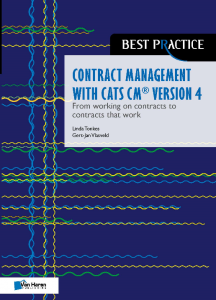CATS CM® methodology – Pillar 2: Roles involved in a contract
Author: Linda Tonkes
The CATS CM® methodology is based on four pillars. The first pillar we described in our previous blog about CATS CM®. In this previous blog we talked about the distinction between the ‘Work To Be Done’ (WTBD), on the one hand, and ‘All Other Contract Matter’ (AOCM) on the other. The distinction between the WTBD and AOCM is what the different roles of the contract manager and the realization and verification manager are based on. However there are more roles involved that emerge due to a contract. The second pillar of the methodology names and defines those roles.
Roles directly involved in a contract
The finalization and execution of contracts means that activities with specific responsibilities (and mandates) must be carried out. These activities and responsibilities can be distributed over several roles. The roles involved in a contract are the following:
- Demand Owner
- Delivery Owner
- Contract Owner
- Authorized Signatory
- Contract Manager
- Realization and Verification Manager
- Service Manager
- Project Manager
- Contract Administrator
- Specialist
This is also illustrated in the following diagram:

In the blog series ‘Contract Management with CATS CM® in a nutshell’, I explain the roles that are most directly involved: the contract owner, the contract manager, and the realization and verification manager.
Contract Owner
The contract owner is the person who is authorized to make the necessary decisions during the execution phase. Such decisions include the final acceptance of the delivered performance, whether or not discrepancies in the performance are acceptable and the ensuing measures, the renewal and supplementing of the (annual) contract budget, the approval of risk control measures, and the initiating and approving of contract changes. This role is often taken up by a demand owner or delivery owner, but organizations can also decide to appoint an independent contract owner or an AOCM specialist. During any critical moments in the contract, the other demand owners or delivery owners remain involved in the decision-making process through the Contract Board.
Contract Manager
The contract manager is responsible for the correct execution of all agreements falling under All Other Contract Matter (AOCM). The activities to be carried out are part of the contract management process and performed on behalf of and with the delegated powers of the contract owner, with the goal of achieving the contract objectives.
Realization and Verification Manager
The realization and verification manager is responsible for the Work To Be Done (WTBD). At the supplier’s organization the realization and verification manager ensures the correct delivery of the products or services. At the client’s organization, the realization and verification manager makes sure that the supplier will be able to deliver the products and services and assesses whether the delivery meets the agreements, for which both the qualitative and quantitative aspects will be checked. There can be more than one realization and verification manager appointed for the same contract. The contract manager and the realization and verification manager(s) must collaborate closely as they are both separately and jointly responsible for the entire contract.
Process owner contract management, a facilitating role
The second pillar of the CATS CM® methodology includes one role that is not directly related to the contract. This is the role of the process owner contract management, who is responsible for facilitating the contract management process. Facilitating can involve training, instructing, creating templates, and making systems available. Because this is such a crucial role for the performance of the roles that are directly involved in the contract, it has been included in the second pillar of the methodology.
Functions and roles
Sometimes, an officer fulfills several roles. The name of the role is not always reflected in the name of the function. When a role is not taken on, or the officer who has to take on a certain role is not familiar with what the role entails, there is a risk that the contract objectives won’t be achieved. The clear defining, demarcating, and vesting of these roles is one of the prerequisites for the successful application of contract management based on CATS CM® and thus, rightfully so, one of the methodology’s pillars.
 Source: https://www.cats-cm.com/blog/cats-cm-methodology-pillar-2
Source: https://www.cats-cm.com/blog/cats-cm-methodology-pillar-2